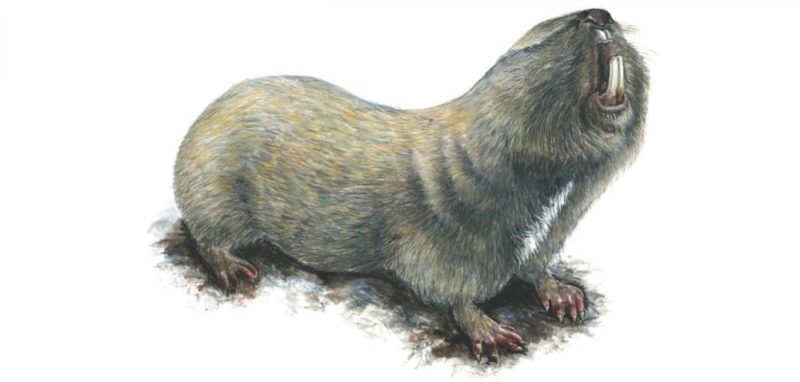Common mole rat, southern Russian or small-eyed (Lat.Spalax microphthalmus) is a mammal of the genus Mole rats, a rodent detachment, living underground. A sufficiently large animal weighs more than 700 g, body length - 20-32 cm.
Material Content:
Features and habitat
To the family of mole rats are:
- common mole rat;
- Bukovinian;
- Podolsky;
- giant;
- sandy.
The animal is very peculiar, has the following distinctive features:
- cylindrical body, neck not visible;
- paws are short;
- the tail is under the skin;
- the shape of the head is flattened, resembles a shovel, if viewed from above;
- eyes are atrophied and hidden by the skin;
- the animal is completely blind, which is why it got this name;
- the outer ear resembles a roller covered with wool;
- the nose is hidden by a black or brown horny plate;
- incisors are large, protrude from the mouth, they are clearly visible;
- the usual color is fawn-gray-brown.
The habitat of mole rats is the steppe and forest-steppe regions of Russia, Ukraine, Moldova. The southern border of the distribution is limited by the Caucasus Mountains. The animal settles among the grass, does not like forest areas and does not climb far into them.
It is sometimes found in forest belts, in clearings, near forest roads. Heaps of land, similar to the mounds of moles, but much larger in size, will help determine his place of residence.
The mole rats are listed in the Red Book of the International Union for Conservation of Nature; therefore, their capture in some areas is prohibited.
Character and lifestyle
Animals from the family Flemish live underground. Almost do not go to the surface. In the ground, this large rodent usually makes branched passages in two tiers.The upper one is fodder, located at a depth of 20-25 cm, the second is nest, which is located at a depth of 3-4 meters.
The length of the moves per animal reaches 450 m, sometimes more. The density of individuals is 3 mole rats per 1 hectare.
The animal is herbivorous, eats tubers, roots and bulbs. In spring and early summer, it eats stems and leaves. Preference is given to legumes, Asteraceae, umbrella crops. For the winter, it stores more than 10 kg of feed.
The character of the mole rat is aggressive. Adult individuals settle separately. In a collision, the case ends with the death of one of the brawlers.
The family consists of a male and two females. In the litter - 2-3 babies. Females give birth in turn.
Nutrition of common mole rat
Common mole rat is a vegetarian, which cannot be said of the mole. In the spring, to feast on the aerial part of the plant, they pull it into the tunnel and eat it there.
Breeding and offspring
Cubs appear at the end of winter, the beginning of spring. The female brings 2-3 babies. After a year, the females leave the nest on the surface, young males leave the nest after two years, most often underground. Many females die during resettlement.
Babies are born naked. Fluffy hair appears after a while.
Life span
Mole rats can be called centenarians. Individual copies can live 9 years. The average life expectancy is 2.5-4 years.
Natural enemies
The natural enemies of the underground inhabitants include the steppe polecat, foxes and large birds of prey. Polecat enters the house of the mole rat and kills the cubs. Birds and foxes feast on young females during resettlement.

Of parasites, helminths, ticks, and fleas are known. Man also harms animals with his agricultural activities, and common mole rats harm humans.
The animal is a pest. Ways to get rid of mole rats
In the garden, the animal can do great harm: carry away the harvest of potatoes, beets, carrots. He does not disdain onions, but he does not like garlic at all. Sometimes destroys young trees.
The fight against mole rats is to lay out baits with strong toxic substances. The drugs resemble poison from rats and are very toxic. It is better to use traps or live traps, but animals rarely get into them.
The mole rats are very aggressive; when fishing, they must be extremely careful not to get wounds and scratches.
Traps and poisons are inhumane methods of struggle. It is better to use water or an electronic repeller. Insert the hose into the tunnel and drain water generously. The animal will try to escape on the surface, at this point it can be caught. But water treatments do not always help. The fact is that the moves are very long. If the soil is soft, the moisture simply spreads, and does not fill the maze.
You can try to arrange a draft by opening one of the moves. The mole rat hates drafts, so it will try to close the hole as soon as possible. Here it can be destroyed.
Interesting facts about the rodent
A mole rat is not a rat or a mole, but a rodent related to guinea pigs and porcupines. Few saw him and are aware of the existence of such an underground resident. And those who had to deal with mole rats would prefer never to see the results of their life hidden from human eyes - plants that disappeared from the garden beds and stolen crops.
Interesting Facts:
- reaches from 3 to 35 cm in length, mass - from 40 g to 700 g;
- naked mole rats are covered with pinkish skin with 100 hairs located on the tail and head. Hair is the organ of touch and helps to navigate in the underground passages;
- incisors grow throughout life, the lower ones can move forward and backward, move apart;
- the teeth are self-sharpening, but this is not enough. The mole rats sharpen their teeth one against the other. In captivity, animals adapt and find the opportunity to sharpen incisors;
- animals possess excellent sense of touch and sense of smell;
- the hair on the body is laid in any direction and this helps to move in opposite directions of the tunnel without obstacles;
- in case of accidental contact with the surface, the animal does not move for some time, then it starts to move in a circle backwards and only after that it quickly burrows;
- mole rats dig earth with powerful incisors, and moles do it in paws;
- in winter they do not fall into hibernation, but activity is markedly reduced.
These animals are less and less found in nature. So that mole rats do not disappear completely, try to be humane, do not kill without urgent need.















